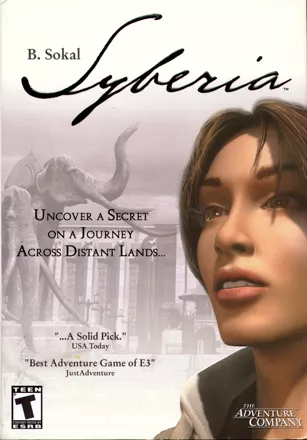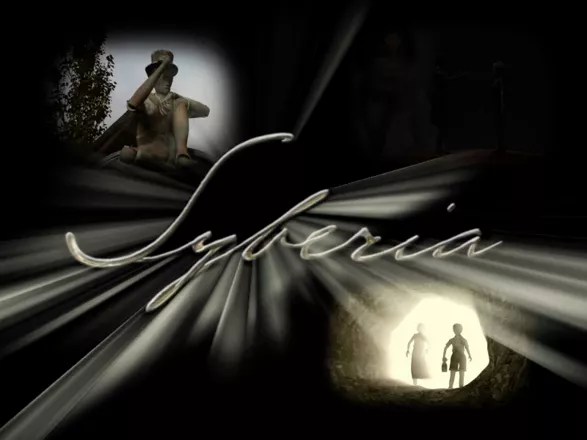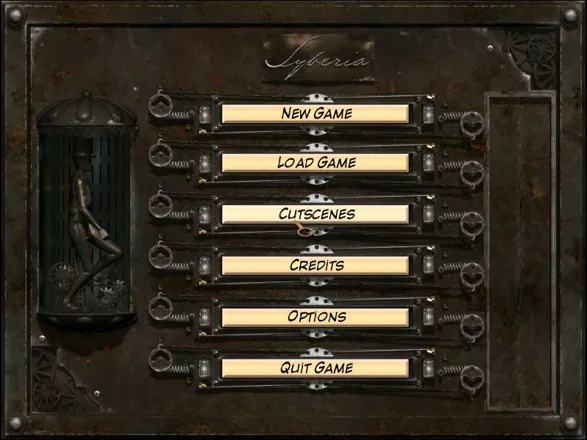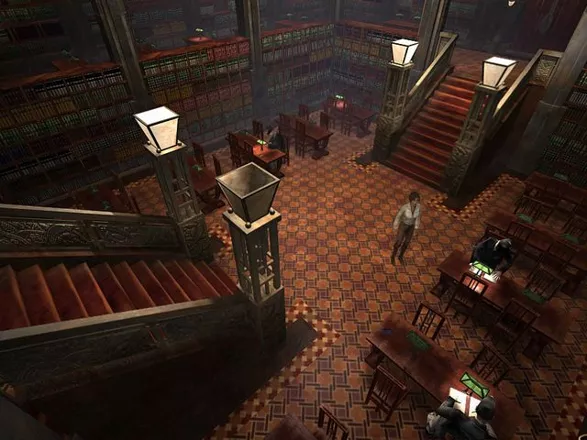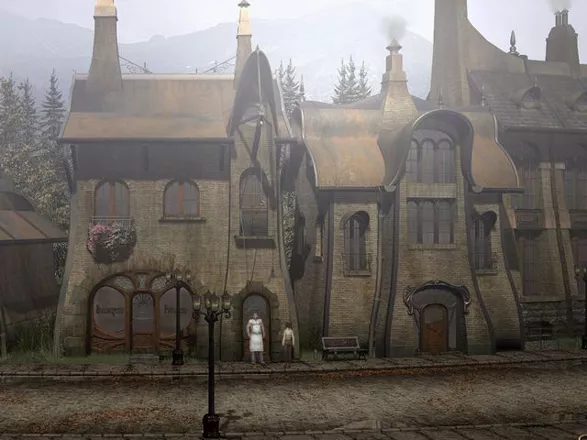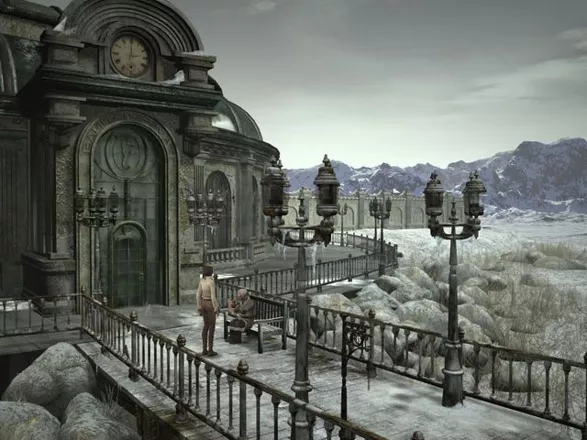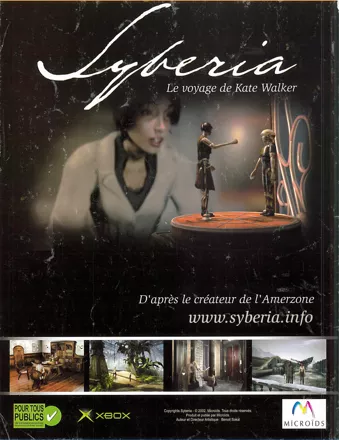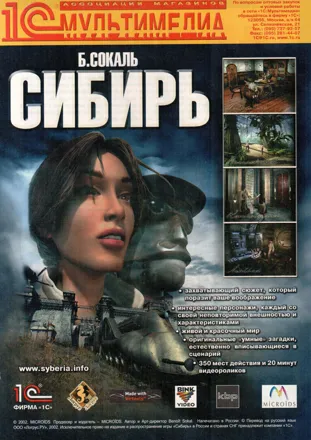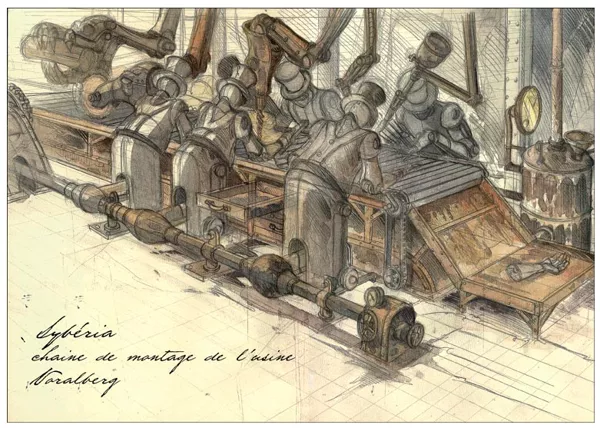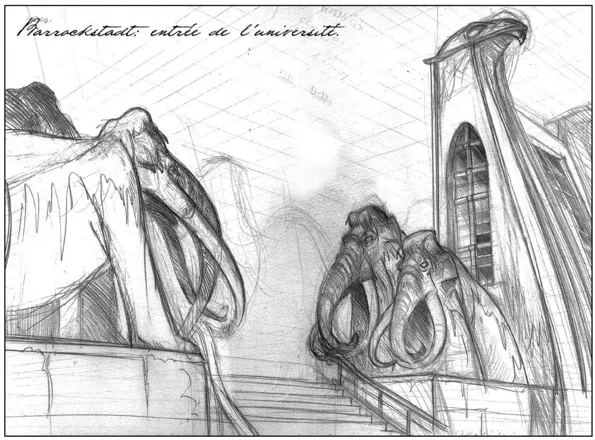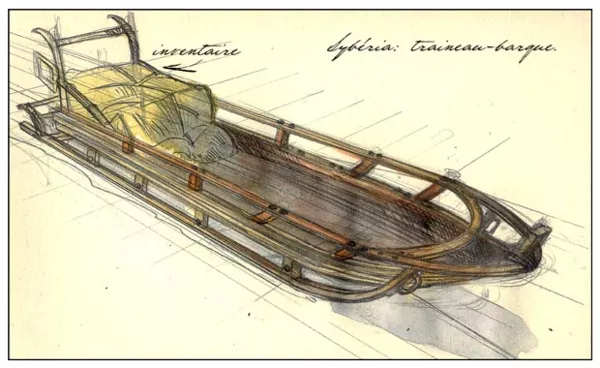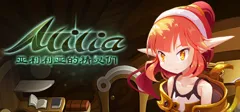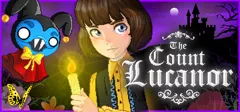Syberia
Description official descriptions
Kate Walker is a lawyer who has been entrusted by the Universal Toy Company to negotiate the takeover of an old luxury toy and automaton factory. Over the centuries, the factory has been developing clockwork devices, specializing in perpetual mechanical movement. The factory's ambitions, however, are ill-suited to the contemporary economic climate, and the elderly Anna Voralberg, at the helm of the Valadilene factory for more than half a century, has decided to sell up.
It turns out that the takeover might not be as straightforward as expected. The day that Kate Walker arrives, Anna Voralberg is being buried. What is more is that she has left an heir – her brother Hans. But Hans had left the valley at the end of the thirties and never returned, and was actually believed to be dead. However, a letter written by Anna in the days leading up to her death reveals that Hans is well and truly alive and living somewhere in Siberia. Valadilene's elderly notary entrusted to take care of Anna's affairs suggests that Kate find Hans Voralberg as he is now the only person in a position to ratify the sale of the family business.
Syberia is a traditional puzzle-solving adventure. The player navigates a 3D model of the protagonist over pre-rendered backgrounds with fixed camera angles. Puzzles are mostly inventory-based, though some involve manipulating the environment (such as mechanical devices). The interface features a single cursor; only highlighted objects can be interacted with, and there are no verb choice commands.
Spellings
- Сибирь - Russian spelling
- シベリア 日本語版 - Nintendo product page Japanese spelling
- 西伯利亞 - Traditional Chinese spelling
- 赛伯利亚 - Simplified Chinese spelling
Groups +
Screenshots
Promos
Videos
Add Trailer or Gameplay Video +1 point
See any errors or missing info for this game?
You can submit a correction, contribute trivia, add to a game group, add a related site or alternate title.
Credits (Windows version)
114 People (101 developers, 13 thanks) · View all
| Author | |
| Art Director | |
| Production Manager | |
| Technical Manager | |
| Project Manager | |
| Lead 3D Modeler & Texturing | |
| Lead 3D Animator | |
| Lead Programmer | |
| Lead Integrator | |
| France-Canada Coordinator | |
| Game Designers | |
| Writer/Editor | |
| Set Design | |
| 3D Modeling & Texture Art - Environment | |
| 3D Modeling & Texture Art - Characters | |
| Animation - Cutscenes | |
| Animation - In-game | |
| [ full credits ] | |
Reviews
Critics
Average score: 76% (based on 67 ratings)
Players
Average score: 3.9 out of 5 (based on 195 ratings with 14 reviews)
The Good
Syberia begins a fascinating tale of a young lawyer Kate Walker, who must locate a heir for Voralberg automaton factory. The heir, Hans Voralberg has left his home village decades earlier to find the fabled island of Syberia, where mammoths roam the land covered with blue grass.
The graphics in this game are in one world beautiful. The whole game is made with pre-rendered graphics, while the characters are 3d-models themselves. The music and the voice acting are good as well.
Most of the puzzles are pretty logical and in places the game is almost far too easy. From this reason the game doesn't give out much of clues, as if it would, even the not so seasoned adventure gamers would run through the game in a day or two.
From time to time the story goes forward with stunning CGI-animations, which range from the train leaving from the platform to an aging opera singer doing her last appearance in a dying mining town. You can watch these animations later, if you so wish, as they appear in the cinematics menu of the game.
The Bad
Despite the fascinating story some of the dialog is pretty awful. There also is a fair amount of running between places, because the game is full of screens, that are there just to, well, amaze the player of how much time was put in to making those stunning surroundings.
The surroundings of the game, despite are animated, feel rather static, as there really isn't much you can operate. There isn't even your standard look-command, which would allow you to examine the area you are in. The game is very limited in that area, and that is a shame, as it would be nice to get some other stuff out of the surroundings despite just the pretty looks.
The Bottom Line
all in all, Syberia is solid, good adventure with a good storyline behind it. Benoit Sokal has managed to create an atmospheric little gem, which provides good, yet rather solid experience.
Windows · by tomimt (397) · 2008
The Good
Syberia was released to nearly-standing ovation from many fans of adventure games. Some went as far as to proclaim it the promised savior of the agonizing genre. So, what are the reasons for the overwhelming praise this game received from critics and players all around the globe?
Syberia was developed by a company that, by that time, had had some experience with adventure games; their previous works were Amerzone and Road to India. Syberia got rid of their "disturbing factors" (the overused Myst-like perspective and atmosphere of the former, the demo-like size and non-existent challenge of the latter) and expanded itself to become a more mainstream, full-fledged adventure game of the ever beloved third-person, point-and-click variety.
Though it does borrow a few elements from Amerzone, it cannot be denied that Syberia has a strong sense of style. That's its most appealing aspect, and that's how it managed to capture the hearts of so many players. The creators of the game let us enter a unique world. Usually, science fiction novels, movies or games are concern with either space travel or all kinds of futuristic machinery. The word "science fiction" becomes immediately associated with highly advanced electronics, spaceships, robots, and overly intelligent maniacal computer systems. But a "retro" science fiction of the beginning of the 20th century, science fiction in little quiet European towns of yesterday - that's quite unusual, and that's what Syberia is about. A strangely interesting world of automatons - mechanical robots - is definitely stylish. This is something no one has probably thought of before, and for that idea the game deserves credit.
A few of the locations are rather imaginative, with some interesting architecture and the elusive mechanical toys contributing to the peculiar charm. There are some nice gameplay elements here and there. You may rejoice at the occasional good, fulfilling puzzle and a bit of lively dialogue happening when you least expect it. I liked the idea of the protagonist communicating with her friends and family over the phone - particularly because that wasn't connected to any in-game activity and was there simply to flesh out the rather indifferently-acting main character a bit more.
Syberia has good production values. The pre-rendered background graphics are detailed and aesthetically very pleasing - though, in my opinion, the art is somewhat cold and cannot quite compare to the majestic beauty of the similarly-looking The Longest Journey. Also, everything is done in grayish tint - which is probably intentional, conveying the occasionally atmospheric, bleak solitude of the game's world.
The Bad
Syberia may be the next hippest thing in the world of 2D background art or even a clever metaphorical tale of human life for all I care, but it is not a good adventure game.
Most adventures live and die with their puzzles, and that's where Syberia fails utterly. There is no spark or inspiration in the puzzles at all. After you finish the game, only the cocktail preparation and perhaps one or two other tasks would linger in your memory for a while. Everything else is forgettable at best, and more often irritating. The mechanical puzzles are uniformly dull; inventory-based activities come across as pathetic shadows of the merry experimentation we knew from the comedy adventures of yore. Worse, however, is the fact that most objectives force you to run back and forth through lifeless landscapes from a solitary character to an obscure item well-hidden in the backgrounds, to an extent rarely seen in the classic representatives of the genre due to the game's abysmal linearity and lack of interaction. Even more so than other contemporary adventures, Syberia discourages experimentation and any kind of creative thinking; it contains almost no optional actions at all, grabbing your hand and sending you on an on-rails museum tour, occasionally sticking your nose into a puzzle that has to be solved here and now.
The puzzles are also poorly balanced. You encounter them virtually in every location you visit, and many of them are elementary easy to solve right away. As a result, you are able to actually solve many puzzles without even knowing that. Since you can't get stuck or die in the game and there are usually only very few things the game allows you to do, the puzzles often refuse to follow the cardinal rule of logic (first find out why you need to do something, then do it). Because of that, most puzzles feel like amateurish imitations of classic gameplay devices pasted into the game without a good reason.
The story of Syberia starts strong, but unfolds itself much too slowly. There is absolutely no sense of urgency in the development of the plot. It is as if the designers decided that the stylish setting alone would be enough to guarantee good storytelling. The whole game is spent overcoming ridiculously irrelevant obstacles while searching for a missing person. You could sum up this story in a couple of sentences. Nothing really significant happens in the game. True, the ending is not bad compared to the rest of the game, but to suffer hours of unexciting gameplay without any real story advancement just in order to see this ending is a bit exaggerated.
Syberia is also a very dry game. It sorely lacks emotions. Its attempts at humor are infantile at best. Its characters feel artificial and uninspired. You know there is a problem with the character cast of a game if its most interesting character is a mechanical robot, and even he comes across as forced with his uneasy goofiness. And all those dry characters will force you to engage in equally dry conversations with them. There's a lot of dialogue in the game, and almost all of it is dull. Almost the only exception I can think of is that guy hitting on Kate in different languages.
The Bottom Line
Syberia was met with joy by critics and players alike. People were longing for an adventure game, and this one was undoubtedly better than most of its genre cousins released at that time. To me personally, the success of this game only highlighted the gravity of the death sentence imposed on adventures. It's the story of The Longest Journey once again - except this time involving a lesser game.
Windows · by Unicorn Lynx (181775) · 2014
A transitional moment for adventure games
The Good
* Unique story, characters, and setting not usually seen in games
-
Good visual presentation
-
No illogical or unfair puzzles
The Bad
* Puzzles are too easy -
Script issues, including pacing
-
Hit-or-miss voice acting
The Bottom Line
Upon its release in 2002, Syberia was hailed as an instantly classic adventure game. Some even referred to it at the genre’s savior. Written and directed by Belgian comics artist Benoit Sokal, the game is a followup to his 1999 adventure Amerzone and is set in the same universe. With a low, accessible difficulty and focus on narrative, Syberia is best viewed as a transitional game between the puzzle-driven adventures of old and the modern breed of adventure games from developers such as Telltale Games and Dontnod Entertainment, which are purely narrative driven.Syberia follows the story of an American lawyer named Kate Walker. Walker is trying to close a deal between the conglomerate Universal Toys Company and the Voralberg company in France which for centuries has been manufacturing mechanical wind-up toys and automata. In the age of computers and cell phones, Voralberg’s toys have become increasingly irrelevant. When Kate arrives in France, she is surprised to discover that Anna Voralberg, the factory’s owner, and the person whose signature is needed to complete the deal, has just died. After doing some investigation, Kate discovers that the company has a secret heir - Anna’s long-lost brother Hans Voralberg. Making use of a clockwork train and driver automaton named Oscar that Hans designed, Kate undertakes a journey across Europe and Russia, through significant places in Hans’ past, to hopefully track him down. All the while, Kate’s relationship with her boyfriend Dan becomes increasingly strained as she moves farther and farther east.
Unlike most video games, Syberia’s plot is very relaxed, while still retaining an epic scope. There are conflicts to solve, but nothing particularly menacing or dangerous happens to Kate for most of the game. Everything is resolved without violence or even much conflict.The only exception to this comes during the game’s climax, which features an obvious villain trying to kill Kate. This actually comes across as quite jarring given the tone of the rest of the game, which up until that point has been focused on intimate conversation and world building, rather than action.
The visuals and settings of Syberia are one of its main selling points. Drawing from art nouveau and clockpunk designs, Syberia presents a very original setting, with technology that is primarily powered by purely mechanical, rather than electrical means. The train that Kate rides throughout the journey is entirely spring-powered and must be rewound at every stop. Even the automaton characters are implied to be using incredibly advanced mechanisms rather than electricity. Of course, technology still hasn’t advanced to the point where even an electrical automaton like what is presented here is possible, but the rest of the setting helps you buy into it. Indeed, the conflict between the past (mechanical) and present (electrical) is one of the plot’s main themes. Most of the early environments are very mechanical and retro, but as you get farther along Kate’s journey and further into Hans’ history, the designs start to be come a bit more computerized, while retaining a mechanical feel. It’s a neat trick. Technically, the game uses the popular style of the era: 3D characters superimposed over pre rendered 2D backdrops. Many backgrounds have moving FMV elements, though there are a few times when details that should be moving are static (such as flowing water) that can make some scenes look a bit odd. Animations are fine, though there are times when characters are speaking that they can sometimes appear choppy.
Mechanically, Syberia is as basic as inventory-based adventures get. Most objects can only be interacted with in one way, and nearly everything you pick up is either used to solve a puzzle or provide background information on the story. When talking to characters, Kate can choose several one-word options from a notepad which changes depending on the situation. This can make it tricky at times to figure out what Kate will actually say, as there are times where the option has the same name but the resulting dialog is different depending on the situation. I just ended up clicking on every response to see what Kate would say. Thankfully, this isn’t a choice-and-consequence game, so I could click on dialog options without fear of messing up.
Syberia is primarily a narrative driven game. It’s easy to lose yourself in the game’s characters and lore, which showcases the broad and beautiful imagination of Benoit Sokal. The game is more about simply taking in the sights, sounds, and history of the world. As a result, the puzzles of Syberia are surely among the easiest to ever appear in an adventure game. I never even looked at a walkthrough one time, and only very rarely was I even close to being stumped as to what I was actually supposed to do. The vast majority of puzzles are simple use item on object puzzles. There’s no combining items in the inventory either. The rest of the puzzles are simply about figuring out how to use an array of mechanical devices. You’ll hunt for codes and keys to start machines up, then fiddle with them for a bit until they work. Only one early puzzle required any guesswork to solve, but even then the amount of guesses it takes is very low. I will say that there wasn’t a single puzzle that didn’t make logical sense, even if some of them felt a bit contrived. I almost have to wonder what the game would have been like if it had no puzzles, as these only seem to be here because the adventure game genre demanded it at the time.
As a result of this approach, Syberia is sometimes bogged down with long, talky sections that seem to exist simply to waste your time. One part of the game requires you to talk twice to three different characters in order to obtain a key item. This means lots of traipsing through numerous screens and sitting through their banal conversations.
The writing and voice acting are hit and miss but do manage to remain compelling in the end. Some of the characters have excellent voices behind them, while others seem to lack enthusiasm and emotion, which can make certain moments fall flat. Even the lead character’s acting can be inconsistent, as some lines land far better than others. The writing can be a bit stiff as well, with needlessly long conversations and responses that don’t entirely make sense given their context.
The music can be good, but like recent games such as Breath of the Wild, the game mostly relies on ambient sounds to set the mood and only occasionally plays music. It’s often very melancholy but occasionally magical, which suits the game’s mood very well.
The version I played on my MacBook Pro was clearly based off of a recent mobile port of the game and isn’t actually the original release. Parts of the interface have cheap-looking comic sans fonts and oversized icons that are clearly meant to be tapped by a finger. There are also annoying achievement icons for when you make progress in the game, and reading documents require you to swipe the mouse up and down in order to scroll through them. In addition, all interactive objects are marked, with absolutely no way of turning this off. This eliminates issues with pixel hunting, something that would make this game hard to play on a small screen. At the same time however, it can feel a bit too much like a gimme for a game that is already very easy. While I don’t regret experiencing the game in this manner, I will say that the only way to get the pure experience is with the Windows version.
While I certainly enjoyed my time with Syberia, I wouldn’t necessarily consider it an amazing adventure game. The writing is stiff at times, and the puzzles are so easy as to be almost non-existent. Nevertheless, the world is beautifully designed and the story is compelling, even if you’ll have to wade through a lot of slow parts to experience it. It’s an adventure game designed for those who want to experience an adventure, rather than bust their brain over difficult puzzles, something that would eventually become the norm with the genre.
Macintosh · by krisko6 (814) · 2018
Discussion
| Subject | By | Date |
|---|---|---|
| Who Was the Model for Kate Walker? | null-geodesic (106) | Dec 1, 2007 |
Trivia
Language
The words written on the control panel of the airship in Kolmkozgrad are authentic Russian. However, the name of the hotel in Aralbad is written incorrectly.
Marketing
Some German games magazine editors received a postcard from New York with a handwritten text from someone called Kate who wrote in German, that she had an Austrian uncle, some problems and so on. There was no clue that this was a PR-event for the game Syberia, even the fake-handwriting was done with some smeared ink.
PlayStation 2 version
Contrary to the Xbox release, the PS2 version did not appear in North America, as SCEA did not approve the game there.
References
- The rat from Road to India makes a cameo appearance in Syberia. It appears in the basement in Kolmkozgrad, makes exactly the same movements it did in Road to India, and disappears.
- Syberia contains some references to another game by Microids, Amerzone . In Barockstadt you can read and hear a lot about different species of Amerzone's flora and fauna.
Awards
- Computer Games Magazine
- March 2003 (Issue #148) - #10 overall in the "10 Best Games of 2002" list
- Computer Gaming World
- April 2003 (Issue #225) – Adventure Game of the Year
- Gamespot
- 2002 - PC Adventure Game of the Year
- 2002 - Best Artistic Graphics
- Gamespy
- 2002 - PC Adventure Game of the Year
- IGN
- 2002 - Best Adventure Game (Readers' Choice)
Information also contributed by Felix Knoke, Jeanne, PCGamer77 and Sciere
Analytics
Upgrade to MobyPro to view research rankings!
Related Sites +
-
Another good walkthrough
MaGtRo's Walkthrough for Syberia -
Microids' Official Walkthrough (in English)
Original walkthrough published by the developer -
Microids' Official Walkthrough (in French)
Original walkthrough by Microids in French -
Solution in Hint Form
If you'd rather get subtle hints to help you along, this file will get you to the solutions at your own pace. -
Syberia
Official Site - Adventure Company -
Walkthrough
If you get stuck in game, use this site to help you out of trouble and continue playing. -
Walkthrough by Witchen
Witchen's Syberia solutions -
Zarf's Mini-Review
A mini-review of Syberia by Andrew Plotkin (March, 2004).
Identifiers +
Contribute
Are you familiar with this game? Help document and preserve this entry in video game history! If your contribution is approved, you will earn points and be credited as a contributor.
Contributors to this Entry
Game added by Isdaron.
PlayStation 3, Nintendo DS added by Charly2.0. Linux added by Plok. Android added by Ingsoc. Nintendo Switch added by Kam1Kaz3NL77. Xbox 360 added by Kennyannydenny. PlayStation 2, iPad, iPhone, Blacknut added by Sciere. Xbox added by LeChimp. Macintosh, Windows Mobile added by Kabushi.
Additional contributors: frin, Unicorn Lynx, Jeanne, tarmo888, Sciere, Zeppin, Paulus18950, Patrick Bregger, Rik Hideto.
Game added June 28, 2002. Last modified April 2, 2024.
